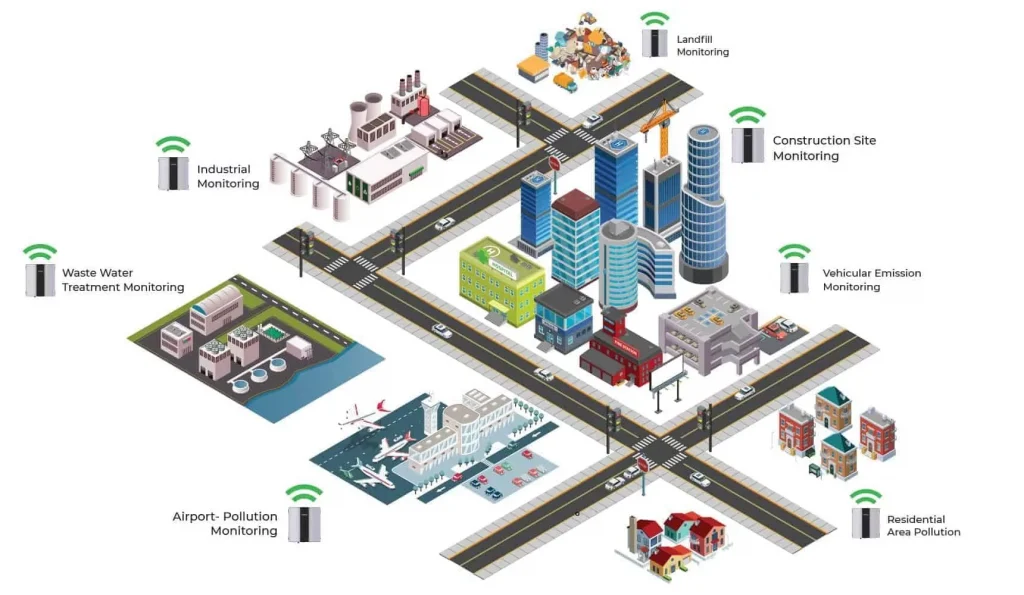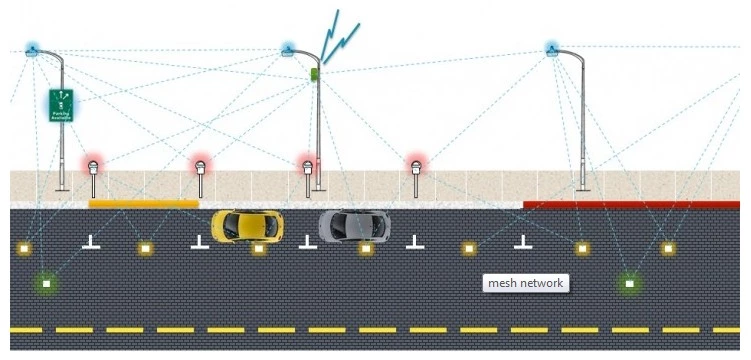Innovation Alphabet
Smart City
In a nutshell
Smart technology is extending and growing in size: from watches and cell phones it has moved to cars, and finally to cities. The smart city is a new urban reality driven by sustainability. A self-sufficient urban environment where traditional networks and services are made more efficient through the use of digital technologies.


Application Fields
• Environmental management: Sensor networks for environmental monitoring are systems that, applied within smart cities, keep an eye on the management of natural resources. One example is water management, which aspires to minimize waste through closer monitoring of aqueducts. In addition, it exploits energy-efficient pumping and recycling of water not intended for drinking purposes.

• Smart Buildings: A smart building is one whose management systems are automated. A total supervisory infrastructure aims at reducing energy consumption and ensuring the comfort, safety, and health of the occupants. For this purpose, there are Integrated and Open Building Automation and Control Systems. They integrate and optimize the management of a building’s services, such as heating or lighting. Building automation is a key area of development for a smart city that aims to achieve greater efficiency in home environments.
• Digital identity: Every citizen today can quickly and securely access public and urban services. How? Through computing devices such as smartphones and computers, by manifesting their digital identity. This is a recognition system that, first, ensures a more agile use of the services offered by the Public Administration (e-government). Second, it allows citizens to actively participate in the administrative life of the city (e-democracy). Digital identity is a priority in the innovation process for citizen services.
Industries
• Smart City in the healthcare industry
Over the past decade, the Italian autonomous province of Bolzano, Trentino Alto Adige, has been promoting public policies to become a smart city. Between 2009 and 2011, the city launched a project with the aim of testing innovative ways to make it easier for elderly people living alone to stay in their homes. This is the “Abitare Sicuri” project. Water, gas, smoke, humidity, and temperature detection sensors have “invaded” homes in order to send data to software which can detect any dangerous situations. Elderly citizens’ feelings of wellbeing and safety have increased.
• Smart City in the energy industry
The city of San Jose, California has initiated a project to replace all 62 thousand light poles with smart streetlights. It features an LED lighting system capable of consuming 40 to 60 percent less energy and connected by a WAN network. This allows for continuous monitoring of streetlight status, activating them only when necessary. The result will be a distinct economic and environmental benefit.
• Smart City in the service industry
Streetline is a U.S. company that offers smart parking solutions accessed through the use of technological infrastructure. It then helps drivers locate free parking spaces through an app. This reduces negative externalities borne by the community through a better alignment between supply and demand guaranteed by a dynamic pricing system, which allows the hourly rate to be increased in areas of high demand and decreased in areas of lower demand. The company’s business model, in addition to the city’s public parking authority and private parking owners, also involves merchants, and it is based on the presence of a short-range connection system.

Do you have a Strategy & Innovation challenge to tackle? Let’s face it. Together.
C-levels from these companies (AND MORE) relied on my expertise to overcome thEIR CHALLENGES IN THIS AREA. And You can, too.
Can I help you?Business Function
• Smart City in support of management
Milan, Italy’s ultimate smart city, uses Big Data Management in order to understand data and transform it into strategic actions for the delivery and development of new services to citizens. One example is the Citizen’s File, a kind of personal identikit that contains household master data, information on education services, tax documents, and a link to online mobility services.
Stay in wonderland
Let me show you how deep the rabbit hole goes.
Check out more of the Innovation Alphabet:

3D Printing
3D Printing
“3D printing” is a process carried out by an electronic device which, instead of resorting to the canonical ink, it molds almost any kind of material: from concrete to living tissue, most usually plastic, but also metal. And the operating principle is similar to that of a traditional printer. The creation of three-dimensional models can lead to the redesign of a company’s production capabilities.
Dive In
5G
5G
5G is the new frontier of cellular telephony. It was designed to improve (or completely replace) previous generations of mobile networks. The 5th generation features lower latency, ensuring flawless performance of business applications and many other digital experiences – thus enabling the new cultural generations to furiously play Fortnite away from home.
Dive In
Advanced Analytics
Advanced Analytics
The term “Advanced Analytics” refers to the ability to autonomously or semi-autonomously analyze data and content to identify correlations, develop analyses, predictions, and recommendations. It is not just a matter of collecting information and then organizing it into watertight compartments: the ultimate goal is to identify a dialogue pattern from a data-driven perspective.
Dive In
Agile
Agile
Agile is an approach to software development designed to respond to change. Teams quickly analyze the context in which they operate, identify uncertainties faced, and figure out how to adapt to always move forward. Interaction between individuals comes before processes and tools; collaboration with the customer is more important than negotiating contracts.
Dive In
Ansoff Matrix
Ansoff Matrix
The Ansoff Matrix is a marketing planning model that arises from the intersection of new and existing products and markets. It derives four possible strategies for expanding the company’s market, which are built around four variables with a changeable factor of risks and possibilities: existing product, new product, existing market, new market.
Dive In
Artificial Intelligence
Artificial Intelligence
Artificial Intelligence is not strictly defined. Basically, it is a computer system able to make decisions in an independent and flexible way. A good AI application can perform everyday tasks better than an average person (e.g., identifying other people from their photos on social media or beating the best chess player). Nothing to fear, then. Unless you are a chess champion.
Dive In
Artificial Scarcity
Artificial Scarcity
We often tend to desire what we cannot have. Or what we are in danger of losing: Artificial Scarcity is a strategy that flaunts a limited number of items that do not correspond to actual availability. The goal is to stimulate the perception in consumers that the stock of items is about to run out and thus create a need based on the “fear of being cut off” or the intention to buy the item in order to resell it at a higher price.
Dive In
Attack Surface
Attack Surface
The term attack surface refers to the part of a system that may be subject to attack or breach by hackers. The smaller that surface is, the easier it will be to protect it. Indeed, the Internet is an ocean of deep, dark waters: those who navigate it must be aware that they are exposing themselves to a flood of digital risks. Yet, ironically, we do not need a big boat to shelter us.
Dive In
Augmented Reality
Augmented Reality
Augmented Reality is an ever-evolving technology that overlays multimedia information on top of our common sensory horizon to gain a deeper understanding of our surroundings. No, it doesn’t allow you to step out of the Matrix dream simulation, nor can it be accessed by swallowing a red pill. But neither is it the disturbing experience of the Playtest episode of Black Mirror.
Dive In
Balanced Scorecard
Balanced Scorecard
In business, as in life, you need balance. The Balanced Scorecard is a holistic tool for strategic management. It offers, in fact, the possibility of assessing corporate performance in its wholeness. An overview that embraces four perspectives: the business/financial side, customers and stakeholders, internal processes, and learning and growth.
Dive In